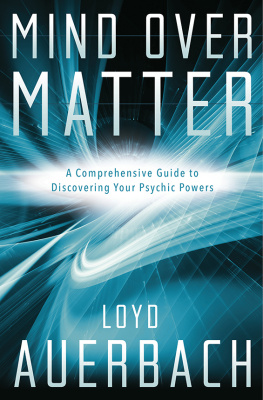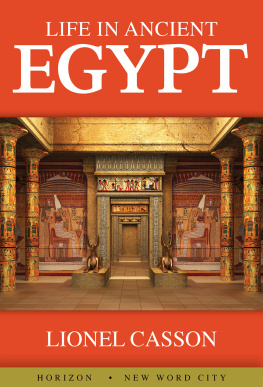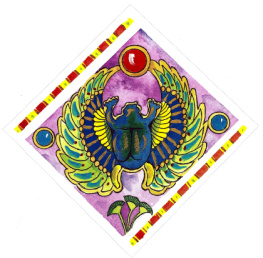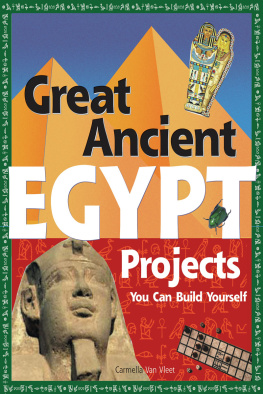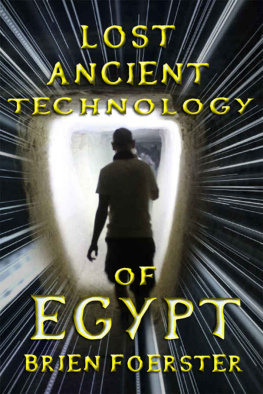Auerbach - Ancient Egypt: A Guide to the Gods, Pharaohs, Dynasties, and Traditions of Ancient Egypt
Here you can read online Auerbach - Ancient Egypt: A Guide to the Gods, Pharaohs, Dynasties, and Traditions of Ancient Egypt full text of the book (entire story) in english for free. Download pdf and epub, get meaning, cover and reviews about this ebook. year: 2016, genre: Religion. Description of the work, (preface) as well as reviews are available. Best literature library LitArk.com created for fans of good reading and offers a wide selection of genres:
Romance novel
Science fiction
Adventure
Detective
Science
History
Home and family
Prose
Art
Politics
Computer
Non-fiction
Religion
Business
Children
Humor
Choose a favorite category and find really read worthwhile books. Enjoy immersion in the world of imagination, feel the emotions of the characters or learn something new for yourself, make an fascinating discovery.

Ancient Egypt: A Guide to the Gods, Pharaohs, Dynasties, and Traditions of Ancient Egypt: summary, description and annotation
We offer to read an annotation, description, summary or preface (depends on what the author of the book "Ancient Egypt: A Guide to the Gods, Pharaohs, Dynasties, and Traditions of Ancient Egypt" wrote himself). If you haven't found the necessary information about the book — write in the comments, we will try to find it.
Ancient Egypt: A Guide to the Gods, Pharaohs, Dynasties, and Traditions of Ancient Egypt — read online for free the complete book (whole text) full work
Below is the text of the book, divided by pages. System saving the place of the last page read, allows you to conveniently read the book "Ancient Egypt: A Guide to the Gods, Pharaohs, Dynasties, and Traditions of Ancient Egypt" online for free, without having to search again every time where you left off. Put a bookmark, and you can go to the page where you finished reading at any time.
Font size:
Interval:
Bookmark:
Ancient Egypt
A Guide to the Gods, Pharaohs, Dynasties and Traditions of Ancient Egypt
What makes Egypt so fascinating to us that there is a branch of archaeology called Egyptology? What did the ancient Egyptian culture have that makes it worth studying? Sun, sand, and pyramids await visitors in Egypt today, but what about the civilizations Egypt was built on? What did they find 5000 years ago to make them want to build a life in Egypt? To understand Ancient Egypt, one must also have a basis in time. When did the first settlers arrive in Egypt? When were the first pyramids erected? When did the first Pharaoh start ruling Egypt as a country in its own right? All of these questions and more will be answered for you, to help you understand that sometimes history has lessons for us- perhaps forgotten lessons that need to be brought back.
A Timeline of Ancient Egypt
Ancient Egypt is considered to be the period in time from 5000 BC to 332 BC. Little is known about the pre-dynastic period because few records exist. However, the period lasted for nearly 2000 years. Civilizations cropped up around the Nile and in Northern Africa along other water sources. These communities were based on agriculture and hunting. Trade between the groups occurred in order to share resources, and it opened the way for arts and crafts, politics, religion, and technology to develop.
Approximately 300 years before the pre-dynastic period ended in 3100, two kingdoms rose to power. One was called the Red Land, which was in the north of Egypt along the Nile River Delta, perhaps extending as far as what is now Atfih. The other kingdom was the White Land in the south, which was probably the area between Atfih and Gebel es-Silsila.
Did you know: Hollywood movies like The Mummy and The Mummy Returns are based on facts pulled from Ancient Egyptian history. The King of the southern kingdom was known as Scorpion. Scorpion tried to conquer the Red Land in 3200BC. However, he was not successful.
It was a century later before the two kingdoms would become one under King Menes. King Menes assumed the title of Pharaoh, which meant King in Egyptian, and he ruled over the first dynasty of Egypt.
King Menes began the Archaic Period, which lasted from 3100 to 2686 BC. King Menes lived and ruled Egypt in White Walls. White Walls, now called Memphis, was the capital of Ancient Egypt. It rests on the apex of the Nile Rivers delta. It was this capital that arose as a metropolis, dominating Egyptian society during the Old Kingdom Period. It was this period that was responsible for founding the Egyptian Society, the ideology of kingship and the religious beliefs in the gods like Horus. Irrigation, fertilization and better farming were discovered during this period.
Egypt is broken into periods by archaeologists. The next periods were as follows:
Old Kingdom - 2686 to 2181 BC
First Intermediate Period - 2181 to 2055 BC
Middle Kingdom The 12 th Dynasty - 2055 to 1786 BC
Second Intermediate Period - 1786 to 1567 BC
New Kingdom - 1567 to 1085 BC
Third Intermediate Period - 1085 to 664 BC
Late Period - 664 to 332 BC
Most of the following chapters will concentrate on the Old Kingdom period. It is the age of the pyramid builders, and it is also considered the third dynasty of Pharaohs. You might recognize a few names from this period such as Imhotep, who was highlighted in the Hollywood films. King Djoser was ruling at the time and asked Imhotep to create a funerary monument for him. The result was the Step-Pyramid at Saqqara.
For the third and fourth dynasties, Egypt was considered a place of prosperity and peace. It was also the time when most of the pyramids were built. This age started to end towards the 5 th and 6 th dynasties, and the wealth of the King was starting to disappear due to the expensive pyramid building. Power was also starting to falter for the Pharaohs with more nobility and priests taking over the power stating that the Sun God Ra was the true power. At the end of the 6 th dynasty King Pepy II died. He was in rule for nearly 94 years.
The period Egyptologists call Ancient Egypt ended when Alexander the Great defeated the Persian Empire. Alexander ruled Egypt until his death then Ptolemy took over control, leaving his descendants in charge. The last Ptolemaic Egyptian ruler was Cleopatra VII - she surrendered to Octavian, known later as Augustus in 31 BC, leaving Egypt under Roman rule for six centuries. When Arabs defeated Roman rulers in the 7 th century AD, Islam was introduced to the country and most of the Egyptian way of life disappeared.
Egypt was not the only civilization to be advancing in 5000 BC. Numerous cultures around the world started to settle, to use their own concepts of agriculture and to trade between various cities as trade routes started to open up. China, Egypt, Europe, and even early civilizations in the Americas existed. But what fascinates us the most about the Ancient Egyptian culture is their advancement in various areas including agriculture, architecture, womens roles and politics. Think about how women are treated in certain cultures even today. Remember how recently American women won the right to vote, and then consider the daily life of Egyptians over 5000 centuries ago that you will learn about in this book.
Keep in mind these other cultures as you explore the daily life, pyramids, architecture, dynasties and Pharaohs of ancient Egypt. Consider what life might be like today if Egyptian ways of life had survived instead of being stamped out by Alexander the Great and the Islamic rule. It is the advancements of ancient Egypt that truly grab Egyptologists attention.
Copyright 2016 by From Hero To Zero - All rights reserved.
This document is geared towards providing exact and reliable information in regards to the topic and issue covered. The publication is sold with the idea that the publisher is not required to render accounting, officially permitted, or otherwise, qualified services. If advice is necessary, legal or professional, a practiced individual in the profession should be ordered.
- From a Declaration of Principles which was accepted and approved equally by a Committee of the American Bar Association and a Committee of Publishers and Associations.
In no way is it legal to reproduce, duplicate, or transmit any part of this document in either electronic means or in printed format. Recording of this publication is strictly prohibited and any storage of this document is not allowed unless with written permission from the publisher. All rights reserved.
The information provided herein is stated to be truthful and consistent, in that any liability, in terms of inattention or otherwise, by any usage or abuse of any policies, processes, or directions contained within is the solitary and utter responsibility of the recipient reader. Under no circumstances will any legal responsibility or blame be held against the publisher for any reparation, damages, or monetary loss due to the information herein, either directly or indirectly.
Respective authors own all copyrights not held by the publisher.
The information herein is offered for informational purposes solely, and is universal as so. The presentation of the information is without contract or any type of guarantee assurance.
The trademarks that are used are without any consent, and the publication of the trademark is without permission or backing by the trademark owner. All trademarks and brands within this book are for clarifying purposes only and are the owned by the owners themselves, not affiliated with this document.
Archaeology gives us a mere glimpse into the past of Ancient Egypt and the Egyptian lifestyle. Many tomb paintings and hieroglyphic texts offer a look into the elitist world, but barely provide any details of regular daily life. Many countries may have been run by Kings and Queens, but it was the peasantry that made up the trade, crafts and food supply any civilization ran on. It was the same for the Egyptians. Pharaohs provided rules and laws, but it was the peasants daily activities that ensured the wealthy could truly live in comfort. If not for peasants running farms, creating crafts and becoming trades people, the wealthy would have had to spend time doing these mundane chores.
Font size:
Interval:
Bookmark:
Similar books «Ancient Egypt: A Guide to the Gods, Pharaohs, Dynasties, and Traditions of Ancient Egypt»
Look at similar books to Ancient Egypt: A Guide to the Gods, Pharaohs, Dynasties, and Traditions of Ancient Egypt. We have selected literature similar in name and meaning in the hope of providing readers with more options to find new, interesting, not yet read works.
Discussion, reviews of the book Ancient Egypt: A Guide to the Gods, Pharaohs, Dynasties, and Traditions of Ancient Egypt and just readers' own opinions. Leave your comments, write what you think about the work, its meaning or the main characters. Specify what exactly you liked and what you didn't like, and why you think so.

